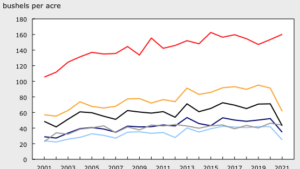How many of us truly take the time to count our plants? Whether it’s by a foot of row, square meter, hula hoop, acre, or by the entire field, the reality is that many of us overlook this critical process. This routine is essential to maximizing genetic potential and optimizing plant expression.
For instance, would the figure of 1,306,800 wheat plants per acre pique your interest? Is it correct or even relevant? Perhaps, the sheer number can be overwhelming. Still, a multitude of factors guides us towards ideal plant populations, making every plant something to cherish. From competitive spacing that is specific to each crop species to variables like soil type, water and nutrition access, row spacing, opener width, topography shifts, season length, and variety type changes—all these factors contribute to bringing out the best in every plant.
Comprehensive guidelines exist to help us identify the ideal plant per acre ratio suitable for each crop’s competitive spacing, with corn and soybeans being the most well-defined examples.
Visualize each seedling as a precious child—nurturing and nourishing it from its infancy, ensuring its survival and growth into maturity. Unfortunately, the industry has somewhat accepted seedling mortality as standard practice. We invest in top-tier genetics, yet somewhat plan for a proportion of it to die upon sowing. This mindset seems counterintuitive in a business with tight margins, but we’ve seen that early-life stress in plants can pose a significant yield risk. However, with the evolution of tools, technology, and farming systems, things have improved. Enhanced equipment, improved seed beds, precise seed placement, and innovative fertility solutions are all contributing to a shift in this status quo.
We must reevaluate and modify our fertilizer practices to reach ideal plant populations. More sophisticated genetics, improved water management, and increased fertilizer rates unfortunately often lead to elevated seedling mortality and stress. This is due to the detrimental effect of fertilizer salts on the tender young plants. We must remember, that plants, especially seedlings, thrive on fertility but wilt with excess fertilizer.
Now, there’s a silver lining: we have alternatives to promote the growth of strong, healthy seedlings. At Taurus, our focus lies in identifying the best nutritional solutions that ensure early uptake and sustained nourishment. Polysulphate Premium from ICL along with Crystal Green or Crystal Green Synchro allow us to provide essential nutrients like P, K, S, Ca, Mg, and trace elements like Cl, B, Zn, right at the seed row. This not only alleviates early plant stress but also ensures efficient, sustainable feeding throughout the season. We’ve coined this strategy as TAPP: Taurus Ag Poly Phosphate. Although Nitrogen is still required for most crops, other largely immobile nutrients can now be placed with the seed or nearby.
Our mission is to shepherd every seedling towards becoming a strong, vibrant contributor to our crop. By accurately calculating plant populations and ensuring easy nutrition access for young plants, we aim to create robust plants capable of driving root exploration and increasing water absorption. This also paves the way for efficient single-pass seeding.
So, let’s count our plants and celebrate our “Lucky Stars,” knowing that with TAPP, every seedling has a promising future.








